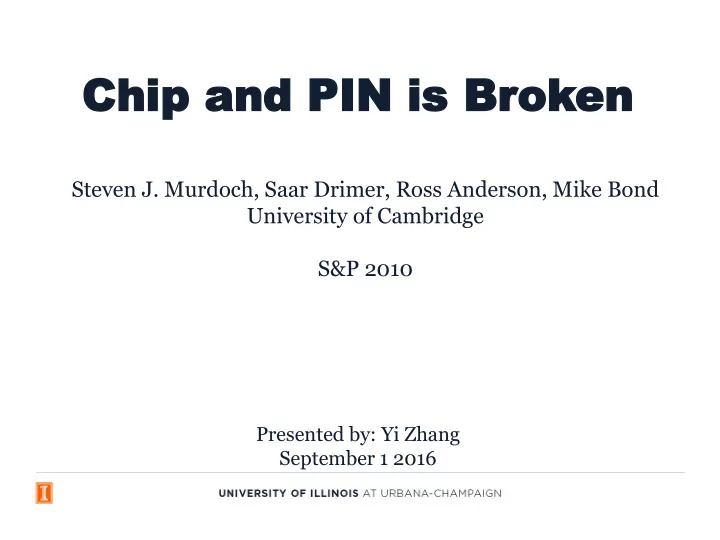

Chip and Chip and PIN PIN is B is Brok oken en Steven J. Murdoch, Saar Drimer, Ross Anderson, Mike Bond University of Cambridge S&P 2010 Presented by: Yi Zhang September 1 2016
EMV Card • As of early 2008, there were 730 million EMV cards in circulation. • EMV Card claimed to secure transactions by “ Chip and PIN ”: Allows PIN-based authentication, even for offline transactions Chip to prevent card counterfeiting PIN to prevent abuse of stolen card
Ef Effect ect on F on Fraud aud Banks claim EMV is infallible, so victims could not get their money back.
They were wrong • In the paper, the authors demonstrate a protocol flaw which allows criminals to use stolen EMV cards without knowing the PIN. • A man-in-the middle attack is possible to trick the terminal and the card. • Live demonstration: https://www.youtube.com/watch?v=1pMuV2o4Lrw
A simplified EMV transaction
What went wrong? • In Cardholder Verification phase, the PIN is verified offline . – The card returns 0x9000 if PIN matches, otherwise returns 0x63cX, where X is the number of further PIN verification attempts. – The card response is NOT directly authenticated. • In Transaction Authorization phase , the authenticated information could NOT provide an unambiguous encoding of the events which happened in the protocol run. – The TVR generated by the terminal in the transaction description is only set if PIN verification has been attempted and failed. – The IAD generated by the card contains information about whether PIN verification was attempted but could be parsed by the terminal. – The bank does not know the cardholder verification method chosen, thus could not use IAD to prevent the attack.
How does the attack works? Card: No Card: No (not required) Did PIN verification Was PIN required (not attempted) Terminal: No Terminal: No fail? and not entered? (was entered) (verification succeed)
Possible Fix • Terminal parses IAD – IAD is only intended for the issuer and has several different format. • The card request CVMR to be included in the transaction description from the terminal – Whether this works depends on the bank system. – Actual implementation doesn’t meet the specification.
Discussion • What are the key contributions of the paper? • Criticisms / limitations of the paper ? • What is the root cause of the problem? • How could we identify the flaw in the protocol design?
Certification of Symbolic Transaction • Erich chen, Shuo chen, Shaz Qadeer, Rui Wang Microsoft Research • Security and Privacy (Oakland) 2015 Website: • https://www.microsoft.com/en-us/research/project/certification-of- symbolic-transaction/
Problem • Security flaws is prevalent in multiparty online service. – The Cloud Security Alliance cites these logic flaws in online services as “Insecure Interfaces and APIs”, the No.4 cloud computing threat. • Why so many logic flaws? – There is no global data storage. – Security is a global property. Local checks at each party sometimes is NOT sufficient to imply the global property.
CST Approach • Tries to verify protocol-independent safety property joint defined over all parties. • Idea: – Collect the trace along the protocol run. – Synthesize a program from the collected trace. • Discard the trace performed at untrusted party or not tamper-proof. – Verify the program against safety property.
Recommend
More recommend